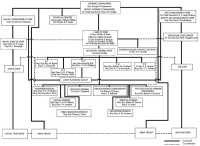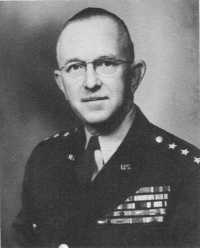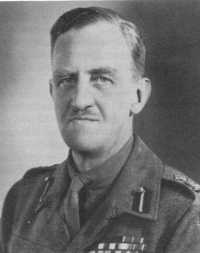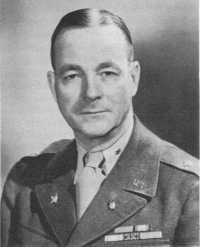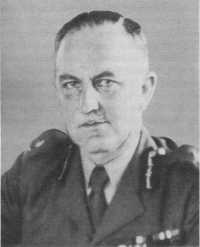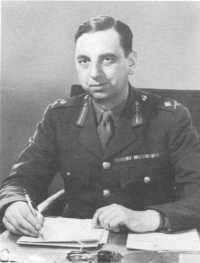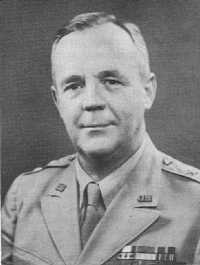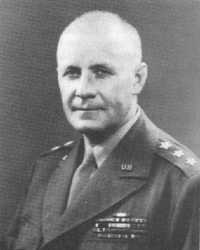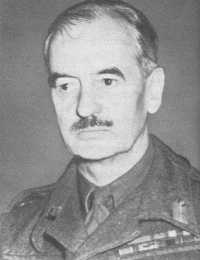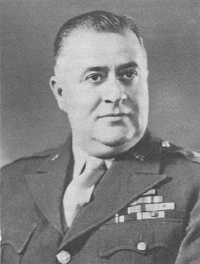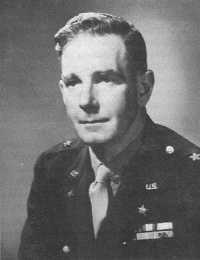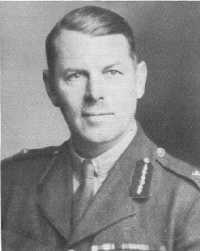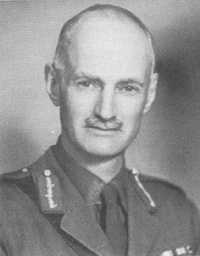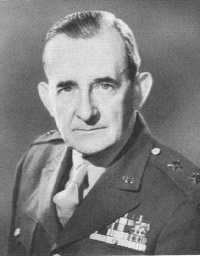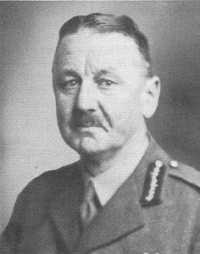Chapter 4: The Machinery of SHAEF
Even before SHAEF had been formed, COSSAC had handed over the tactical planning of the cross-Channel attack to the Commander in Chief, 21 Army Group, the Allied Naval Commander-in Chief, Expeditionary Force (ANCXF), and the Commander-in-Chief, Allied Expeditionary Air Force (AEAF). Later, the detailed planning of the ground force assault was given to the armies involved in the attack. Headquarters, ANCXF, and AEAF drew up detailed plans of their own. As a result SHAEF did not play a prominent role in the operational planning for the initial stages of OVERLORD and may appear to the casual observer to have been almost completely divorced from control of the assault. An examination of the machinery of SHAEF will help to correct this misconception.
The Powers Reserved to SHAEF
General Eisenhower, in appointing General Montgomery to command U.S. and British ground forces in the assault, gave him operational control of the forces to be used in the early days of the attack. The temporary nature of the arrangement was understood. The Supreme Commander, while delegating for an interval operational control of Allied ground forces, did not lay aside his responsibility for making tactical decisions that involved major changes in the OVERLORD plan or the calling forward of additional troops. His intervention was also necessary to get increased air or naval support for the ground forces.
In the administrative sphere, where supply and personnel were concerned, the Supreme Commander retained a large number of duties. As the chief Allied headquarters, SHAEF coordinated interservice and inter-Allied administrative policy. This coordination extended to such matters as policy on the hiring of labor, the purchase of supplies, welfare, health, discipline and awards, prisoners of war, movement, and the construction of airfields. It was the task of SHAEF to prepare outline administrative plans for future Allied operations, allocate scarce resources until shipped overseas, deal on national policy matters with non-U.S. and British powers, determine policy on POL (petrol, oil, and lubricants) matters, and make representations to the U.S. and British ministries and departments concerning policy and materiel requirements when they influenced the theater as a whole.1 (Chart 3)
In the so-called political sphere the Supreme Commander and his staff were particularly busy. Few if any of these responsibilities had been delegated to subordinate commanders. Representing Great
Chart 3: Supreme Headquarters, Allied Expeditionary Force, 6 June 1944
Britain and the United States in relations with representatives of France, preparing for civil affairs administration after the liberation of occupied countries, and planning for military government for conquered Germany were all tasks which the Supreme Commander retained. Somewhat allied to these activities were those relating to press relations, censorship, and psychological warfare—all matters which had to be carefully coordinated at the highest Allied headquarters.
SHAEF also retained active control of long-range planning for the period after the establishment of the bridgehead and the drive into Germany. Before D Day, its staff had outlined plans and amassed considerable data relating to the advance into Germany and the crossing of the Rhine.
The Operations Division
The nerve center of SHAEF was the G-3 Division. Here planning and operations were combined. The chief of this division, Maj. Gen. Harold R. Bull, had been assigned to the operations branch of COSSAC in the fall of 1943 in preparation for his appointment to the SHAEF post. He had previously served as G-3 of the War Department, acted as special observer for the War Department in the Mediterranean theater in the summer of 1943, and then commanded the III U.S. Corps. On 14 February he succeeded Maj. Gen. Charles A. West (Br.) as G-3 of SHAEF. West remained as deputy until May 1944 when he was replaced by Maj. Gen. J. F. M. Whiteley (Br.), deputy chief of staff at Allied Force Headquarters and briefly chief of intelligence of SHAEF. The two most important sections of G-3, plans and operations, had initially been united under Brig. Gen. Arthur S. Nevins; formerly a member of the TORCH planning staff, later briefly G-3 of Fifth Army, and subsequently General Alexander’s operations officer in the Sicilian campaign. Near the end of May 1944 the two sections were separated, but General Nevins continued to coordinate their work. Brigadier Kenneth G. McLean, who had been chief Army planner at COSSAC from the beginning, headed the plans section. In March 1945, Maj. Gen. Lowell W. Rooks (U.S.) was added as deputy to General Bull.
The planning section, designated Planning Staff, SHAEF,2 was set up in mid-March 1944 to coordinate planning for SHAEF operations. Members of the staff included representatives of the Allied Expeditionary Air Force, the Allied Naval Expeditionary Force, and the general and special staffs of SHAEF. They made estimates of the current situation, outlined plans for all future operations, and made detailed plans for the post-hostilities period. Before D Day, this staff worked on plans for taking the Channel Islands, for operations in northwest Europe in case Germany suddenly surrendered, for forcing the Seine and capturing the Seine ports including Paris, for action to be taken in Norway in case of a German surrender, and for a course of action to be followed after the capture of the lodgment area.3
The operations section prepared and issued operational directives and orders based on plans drawn up by the planning staff and approved by the chief of operations and the chief of staff. It drew up and issued detailed standing operating procedures essential to the proper coordination
General Bull (1950 portrait)
General Whiteley
General Nevins
Brigadier Mclean
General Strong (photograph taken in 1945)
of the various arms and services. It also planned projects to mislead the enemy as to Allied intentions. Special subsections dealt with the coordination of airborne operations, defense against chemical warfare, and the arrangements for gathering meteorological information.
The operations section also directed Resistance activities in France outside the 21 Army Group sphere, cooperated with the Psychological Warfare Division in formation of propaganda policy and coordinated its action with operations, provided G-3 operational contact with Allied missions, and coordinated the preparation of communiques. It was also the duty of this section to aid in preparing combined situation and intelligence reports, daily and weekly summaries, reports of progress on current studies, and liaison reports.
An important activity of the operations section was that of maintaining the SHAEF War Room where information was drawn from the Allied Naval Expeditionary Force headquarters, the Allied Expeditionary Air Force, 21 Army Group, the U.S. strategical and tactical air forces, Bomber Command, the meteorological section, Special Force Headquarters, and the G-1, G-2, and G-4 Divisions. Daily and weekly reports summarized this information. In the SHAEF War Room operations officers posted information on future air, ground, and naval plans, the Allied order of battle, including location and numbers of aircraft, the situation of current operations on the eastern and western fronts, meteorological forecasts, the enemy order of battle (including ground divisional strength, the enemy coastal defense system, and the location of major enemy air forces), and G-4 movements and plans.4
SHAEF G-3 maintained liaison with 21 Army Group, the Allied Expeditionary Air Force, the Allied Naval Expeditionary Force, and the Strategic Air Forces. Part of this task was handled by regular liaison staffs which remained at the headquarters in question. The greater part was carried on by personal visits, frequent telephone conversations, and participation in combined conferences. Officers of the G-3 Division made a special effort to visit forward headquarters as frequently as possible. General Bull, who had served for a time in North Africa as an observer for the War Department and, later, for General Eisenhower, took a special interest in this phase
of SHAEF’s work. As the forces under General Eisenhower increased in the winter of 1944 and the spring of 1945, General Bull assumed increasingly the responsibility for maintaining contact with army group commanders. The deputy G-3, General Whiteley, kept in close touch with Maj. Gen. Francis de Guingand, the 21 Army Group chief of staff, and worked out with him personally many operational questions concerning General Montgomery’s forces.
Because of the command situation that existed before D Day, the Supreme Commander found himself relying on two sources of operational advice and information. When, as often occurred during the assault, he was called upon merely to give a nod of approval to a plan proposed by General Montgomery or General Bradley, he was dependent largely upon planning done by someone else’s staff. In such matters as directing Resistance operations, increasing airborne forces for the assault, planning for railway bombing, and other problems involving forces of different services and more than one nationality, he turned more frequently to his own staff.
The Intelligence Division
Before leaving the Mediterranean in December 1943, General Eisenhower indicated that he wanted Maj. Gen. Kenneth W.D. Strong (Br.), G-2 of Allied Force Headquarters, as his chief of intelligence at SHAEF. This officer had served as assistant military attaché in Berlin shortly before the beginning of the war and later for more than a year as head of the German section of the War Office. Eisenhower’s request, coming on the heels of numerous other shifts from the Mediterranean theater, met opposition from the War Office. When initial appeals proved ineffective, General Whiteley was appointed to the post. In May 1944 after further requests by Generals Eisenhower and Smith, the British agreed to the transfer of General Strong, and he became chief of intelligence on 25 May 1944.5 His deputy, Brig. Gen. Thomas J. Betts (U.S.), had come to SHAEF some weeks earlier from the Mediterranean theater.
SHAEF, of course, did not attempt to collect intelligence by interrogating prisoners, nor did it send out air and ground reconnaissance patrols. For this type of information it depended, like the army groups, on the armies and subordinate units. For spot information, it was assumed, the lower headquarters would have to depend on their own resources. Such information was collated at army headquarters and sent back to the army groups and to SHAEF.
SHAEF G-2 received estimates and information from the armies and the army groups, from Resistance groups, either directly or indirectly, from reports of the Office of Strategic Services and the Political Warfare Executive, from the estimates of the War and Navy Departments in Washington, and from the Joint Intelligence Committee (London).6
Shortly after its establishment, SHAEF took over much of the personnel and files of the Theater Intelligence Section (TIS) which had been set up by the British in 1940. Initially British in make-up, this organization added U.S. personnel in 1943.
As a part of British Home Forces and later of COSSAC, the section conducted considerable research on Germany and enemy-occupied territory and collated reports on enemy movements and dispositions. It furnished a mass of topographical information, and detailed reports on enemy order of battle and the location of enemy guns and fortifications. Lt. Col. John Austin, a Magdalen don who had headed the order of battle section under the Theater Intelligence Section, set up a similar section under SHAEF.
General Strong at the end of June 1944 proposed that SHAEF establish a Joint Intelligence Committee (SHAEF) which would consist of one U.S. and one British representative from each service, a British or U.S. member to deal with economic questions, and, when necessary, a British and U.S. member to represent the Political Advisers of the Supreme Commander. Headed by the SHAEF chief of intelligence, this committee was to keep under constant review the military and political situation in the area for which the Supreme Commander was responsible. It was to be the sole producer of intelligence appreciations for the Planning Staff, SHAEF, and to be the final authority on all intelligence matters for SHAEF. As long as SHAEF remained in the United Kingdom, the committee was required to keep in close touch with the Joint Intelligence Committee (London) to maintain a full exchange of information. The system was adopted in July 1944 with General Smith’s reluctant approval. The SHAEF chief of staff indicated that he felt it tended to recognize the “command by committee” system which the Supreme Commander was trying to avoid.7
The varied intelligence which came to Supreme Headquarters was collected, assessed, and passed on to subordinate headquarters in weekly intelligence summaries and periodic estimates. Part of the information sifted down to the lower headquarters either in the form of news summaries or often in the form of annexes appended to the regular reports. These summaries suffered somewhat from a time lag and by no means represented the information available at SHAEF at any given time.8 Certain intelligence that could not be issued generally for fear of endangering the sources naturally had to be omitted from the summaries. Thus, the Supreme Commander and the army groups depended for their most current and most complete information on personal briefings by their chiefs of intelligence or members of the intelligence staffs. The army groups kept the SHAEF staff abreast of developments in their areas with nightly reports direct to Supreme Headquarters.
Much of the work of SHAEF G-2, like that of the Operations Division, was carried on by personal contact between members of the SHAEF and army group staffs. The relationships between members of the G-2 staffs of SHAEF and the army groups were cordial. Unfortunately, the same thing could not always be said of relations between the army groups and the armies.
General Strong organized his group along British lines. His chief deputy, General Betts, had served for some years on the War Department G-2 staff and had attended the Combined Chiefs of Staff conferences at Washington, Quebec, and Cairo in 1943 as a G-2 representative.
The operational intelligence chief, Brigadier E. J. Foord (Br.) had served in the intelligence section of the War Office and then as chief of the operational intelligence subsection of Allied Force Headquarters in the Mediterranean.
Administration
COSSAC had intended initially to follow the British system of putting both personnel and supply activities under an administrative division with subsections devoted to these matters. When a decision was made near the end of 1943 to extend the U.S. system of organization throughout the headquarters, separate G-1 and G-4 Divisions were established. That neither division ever had as much operational control as the G-2 and G-3 Divisions was due chiefly to differences in personnel and supply organizations in the British and U.S. armies which required entirely separate logistic arrangements for the two forces. Control of British troops and supplies for OVERLORD was vested in 21 Army Group. Control of U.S. troops and supplies was given to Headquarters, ETOUSA, which General Eisenhower commanded as the senior U.S. commander in Europe. The actual task of supply in the battle zone was handed over to a U.S. supply headquarters. Administrative control of British tactical air forces was placed under Air Chief Marshal Leigh Mallory as long as his Headquarters, Allied Expeditionary Air Force, existed. Headquarters, USSTAF, retained administrative control of U.S. units assigned to AEAF.
General Crawford
General Barker, who had been deputy chief of COSSAC, became the chief of the G-1 (Personnel) Division of SHAEF. His original deputy, Brigadier R. F. R. Becher (Br.), was replaced in May 1944 by Brigadier T. J. N. Bosville. The G-4 (Supply) chief of SHAEF was Maj. Gen. Robert W. Crawford, who had served as Commanding General, Services of Supply, U.S. Army Forces in the Middle East, and later as chief of staff of the Services of Supply organization in the United Kingdom. He was appointed deputy G-4 of COSSAC in November 1943 with the understanding that he would later exchange places with Maj. Gen. N. C. D. Brownjohn (Br.) then the G-4 of that headquarters. This shift took place in February 1944. General Brownjohn remained as deputy G-4 until August 1944 when he was succeeded by Maj. Gen. C. M. Smith (Br.). In March 1944 three special deputies were added to the G-4 Division to help determine priorities, allocate supplies,
and assign space at railways, ports, airfields, and other facilities to the various services.9
General Lee
Because of General Eisenhower’s dual role as Supreme Commander and as U.S. theater commander, the organization of the supply services in the U.S. zone is significant to this study. To simplify U.S. administration, General Eisenhower in mid-January 1944 ordered the consolidation of Headquarters, ETOUSA, and Headquarters, Services of Supply. This enlarged headquarters inherited the name of ETOUSA, and was commanded by General Eisenhower with General Smith as its chief of staff. It was actually controlled by Lt. Gen. John C. H. Lee, deputy theater commander for supply and administration, formerly the commanding general of the Services of Supply. General Lee was also slated to command Headquarters, Communications Zone, which was to be established on the Continent after the invasion to control supply of U.S. troops. General Eisenhower tended to rely on U.S. members of his SHAEF staff for advice concerning most operational matters, and he used Headquarters, ETOUSA, for communication with the War Department on administrative matters and as an authorizing agency for all U.S. commands that operated under Supreme Headquarters. The exact responsibility of the G-I and G-4 at SHAEF and their counterparts at U.S. supply headquarters was never thoroughly defined. While it was natural for the Supreme Commander to turn to the U.S. staff officers nearest at hand for advice on purely U.S. questions, the G-1 and G-4 at theater headquarters were more closely in touch with the War Department and had closer control of U.S. men and supplies coming to the United Kingdom and the Continent. Staff officers at SHAEF were never completely successful in their efforts to control supply and personnel policy relating solely to U.S. forces. On matters involving allocation of supplies and men among the Allied forces and on certain problems pertaining to the entire British, French, and U.S. force, they played a more important role.10
Civil Affairs
The organization of SHAEF’s Civil Affairs Division (G-5) requires more detailed study than that of the other general staff divisions. Since it was of fairly recent origin, the COSSAC and SHAEF planners had to work out new procedures and systems of operating. Unlike the other general staff divisions, G-5 could not be set up simply by copying long-established U.S. or British practices. Instead, it was necessary to draw on fairly recent experiences of the Allies in the Mediterranean, and these did not conform exactly to the needs of a Supreme Headquarters in the European theater. A second factor making for difficulty arose from differences of opinion between the British and U.S. Chiefs of Staff, between the U.S. Chiefs of Staff and the State Department, between the COSSAC and the AFHQ elements of SHAEF, and between individuals, as to theory of civil affairs and methods of control. Again, because of the political angles involved, SHAEF from the beginning exercised closer control of civil affairs operations than of other operations’. Finally, the Supreme Commander and his chief of staff had to intervene more directly in the final settlement of the civil affairs organization than they did in the case of the other divisions.
Differences Between Military Government and Civil Affairs
At the beginning of World War II, there was no clear-cut distinction between military government and the administration of civil affairs, both of which the G-5 division of SHAEF had to deal with. It was known that military government referred to the authority established in occupied territory of the enemy and that it was intended largely to preserve order in zones in enemy areas through which the victorious armies were passing. The term was applied more often, of course, to the authority that was established in a defeated country after the conclusion of an armistice. In World War I, the practice had been to continue existing local governments in power with military supervision and with some safeguards against disobedience of the orders issued by the occupying power. Attempts were made to restore the previous economic and social framework as soon as possible in order to reduce the responsibilities of military units for feeding the population and running the government.
In World War II an entirely different situation existed. In Italian-held territory in the Mediterranean, and in German territory on the Continent, the Allies undertook to eliminate the former Fascist and Nazi officeholders, to root out the political theories which Mussolini and Hitler had put into the legal systems of the two countries, to change Fascist- and Nazi-inspired economic regulations—in short, to effect a political revolution under Allied auspices. Part of this task was handed over to the military commanders who first set foot on enemy territory. They soon discovered that former views on the subject were not suited to the new concept of military government, and they found, in the early days at least, that they lacked officers with the technical knowledge to assume the tasks of mayors, directors of railways, directors of waterworks, directors of power plants, and dozens of other key jobs which were formerly performed by the party faithful who
now under Allied policy had to be ruthlessly weeded out. Under World War I conditions, it was possible for a commander to restore the former officials, under proper military supervision, and let them govern as before. The new system required the conquering armies to establish new city and district administrations.
Civil affairs had also changed since World War I. It had become clear in that earlier conflict that “total war,” which choked essential highways with great masses of dispossessed people, required commanders to restore some semblance of civil authority if military operations were to be continued. In the 1914–18 period, the British and U.S. armies had been able to leave this problem largely to the French Government and Army, which at most needed only some supplies and transport to restore civil administration. In preparing for the invasion of Europe through France in the spring of 1944, SHAEF realized that the French civil administration that would be found had been either under the control of German military authority or under Vichy. In either case, it seemed likely that the existing government would have to undergo considerable change. Further, the greater damage caused by the bombardments of World War II meant that the liberating armies would have to support the local populations or furnish transport to a far greater degree than they had before. Worse still, they could not expect the French forces, which were themselves being supplied from Allied sources, to take on this responsibility. Inasmuch as hungry civilians, however sympathetic to the Allies, were likely to become dangerous if left unfed, the Allied commanders, as a matter of necessity, had to engage in widespread activities in the realm of civil affairs. Military commanders were not always pleased at having to turn their attention from the task of winning battles to the business of feeding people and of making electric plants and waterworks function again. They were frequently even less willing to have groups of officers from higher headquarters carry out civil affairs activities in the forward zone. As a result, command channels and command responsibility for civil affairs became points of contention among the various headquarters.
Developing a System of Allied Control
General Morgan, who has described the task of setting up a civil affairs organization for SHAEF as “the most vexatious and least satisfactory” of COSSAC’s many tasks, attempted as early as July 1943 to establish a civil affairs branch and to draw up a set of guiding principles for civil affairs planning. Almost immediately he was caught in a debate between the British and U.S. Chiefs of Staff over whether the control of civil affairs should be centered in London or Washington, and in a COSSAC-versus-AFHQ argument over the nature of civil affairs command in the field. There is little wonder that in his description of these discussions, General Morgan recalls the remark of a member of his staff that “there were plenty of affairs, but the difficulty was to keep them civil.”11
The British had a variety of reasons for attempting to centralize civil affairs control in London. Not only had they had considerable experience with governing occupied countries throughout modern history, but they had taken up the responsibility of military government in Italian and African possessions as early as 1940–41.
Before the United States entered the war, the British had established procedures and policy for military government. In June 1942, they formed an Administration of Territories (Europe) Committee under Sir Frederick Bovenschen, Permanent Under Secretary of State for War, to coordinate planning for military government. The commander of United States Forces in Europe was invited to send observers to meetings of the committee, apparently in the hope of making it the combined agency for determining Allied civil affairs policy.
The British were in a position to say that they had a going concern in London and were prepared to lay down military government policy. It is possible that they desired to keep this control in London, not only because they felt themselves in a better position to handle these matters, but because they believed that a London committee could act more quickly on European matters and that decisions affecting British interests would be more satisfactorily settled. Parliament and Congress had expressed some dissatisfaction over U.S. dealings with Darlan in North Africa, and there were indications that Roosevelt and Churchill did not see eye to eye on the question of colonies. The British naturally desired to have firm control over any of their former colonies which might be recovered by Allied forces.
The President wanted to make sure that U.S. forces were not used merely to restore colonies or to carry out a policy in military government laid down by another power. The U.S. Chiefs of Staff were also of the opinion that over-all control of military government could best be handled from Washington. In July 1943, they and the British Chiefs of Staff agreed to establish a Combined Civil Affairs Committee (CCAC) in Washington to control civil affairs and military government policy for all theaters. The charter of the committee gave assurances that, if British or Dominion territory were recovered from the enemy, the nations concerned could submit to the Combined Chiefs of Staff an outline of policies for use in the civil affairs administration of such possessions. The Combined Chiefs of Staff, in turn, were to consult the force commander charged with taking and holding such territory and, on his recommendation, to accept those proposals which would not interfere with the military purpose of the operation.12
Establishment of the committee in Washington did not settle the problem of control. The reasons for continued debate have been well stated by General Morgan:
If territory was to be liberated or conquered by combined forces, then obviously the reinstatement of the life of those territories must similarly be undertaken by combined means. But the British had been at this liberation and conquest business already for some years, and they had set up for themselves an organization to see to this thing. To them it seemed a possibly unnecessary complication to duplicate the British effort in this respect over in the United States of America. It appeared to them that there were two alternatives: one could either reinforce the British setup to give it combined status, or one could regard the British setup as it stood as the British contribution towards the combined effect desired with an equivalent United States outfit in Washington.13
The British attempted to pursue the first of these alternatives by holding that attendance of U.S. observers at meetings of the Administration of Territories (Europe)
Committee constituted combined action on civil affairs and military government matters. When the U.S. representatives rejected this view, the British declined for a number of weeks to deal with the Combined Civil Affairs Committee in Washington. The net effect of this impasse, according to Maj. Gen. John H. Hilldring, chief of the Civil Affairs Division of the War Department, was to deprive the Supreme Commander for three months of any guidance on military government and civil affairs.14
The Combined Chiefs of Staff resolved the problem at the end of January 1944 by establishing the London Sub-Committee of the Combined Civil Affairs Committee. This body was empowered to advise the Supreme Commanders of Europe and the Mediterranean, solve the civil affairs problems which did not justify reference to the Combined Chiefs of Staff, make recommendations on problems referred to it by the CCAC in Washington, and receive from the British Government its views in regard to British or Dominion territory outside the Pacific which might be recovered from the enemy. The Administration of Territories (Europe) Committee was abolished.15 Even after this action, the War Department remained watchful lest the British try to enlarge the powers of the European Advisory Commission, organized by Britain, the United States, and the USSR in London in late 1943 to draw up surrender terms for Germany and Axis satellites and to consider such other questions on liberation of Allied countries as might be submitted by the three governments.16
An illustration of the delays which followed these debates over jurisdiction may be found in the efforts of the United States and Great Britain to conclude a civil affairs agreement with the Norwegian Government-in-exile. Allied negotiations to get an agreement with Norway covering such matters as the restoration of civil authority, the requisitioning of supplies, and the hiring of labor were begun as early as May 1943 by the Administration of Territories (Europe) Committee. The Foreign Office aided in preparing the necessary documents, but negotiations were kept on a strictly military level. The British authorities, wishing to avoid delays which they feared would follow submission of the agreement to the Combined Chiefs of Staff and the Combined Civil Affairs Committee, in July 1943 sent it to General Devers on the chance that he could get direct approval from the U.S. Chiefs of Staff. Their hope proved unfounded, although General Devers promptly gave his assent to the document and proposed that with some modifications it become a model for similar agreements in the future. The U.S. Chiefs of Staff, in order to avoid any precedent which would recognize the authority of the Administration of Territories (Europe) Committee to act on civil affairs matters
for the Allies, asked that both the Combined Chiefs of Staff and the Combined Civil Affairs Committee deal with the matter. An attempt was also made to get reactions of the State Department, but a request for its opinion brought merely the reply of “no comment.” Accepting this as a negative form of approval, the Combined Chiefs of Staff proceeded with a discussion of the final draft. After some delay, which Ambassador William Phillips blamed more on questions of prestige than on details of the document, the British and U.S. Chiefs of Staff also agreed near the end of January 1944 to proceed with Belgium and the Netherlands on the basis of the Norwegian draft.17
Once the Combined Chiefs of Staff had agreed on the general form of the documents, the British and U.S. Governments proceeded to conclude separate accords with the occupied countries. The U.S. Chiefs of Staff in January 1944 maintained that the State Department would have to conclude agreements with these countries in order to make them binding. The State Department, as a matter of fact, already had under consideration draft agreements with Norway and the Netherlands. Secretary of State Cordell Hull held that since these were for military purposes they should be entered into directly between the Commander in Chief, U.S. Forces in Europe, and the countries concerned. At the end of February, the U.S. Chiefs of Staff instructed General Eisenhower to conclude a civil affairs agreement on behalf of the United States with Norway. After a delay to permit the USSR to conclude a similar agreement with Norway, separate accords were signed with Norway on 16 May 1944 by representatives of the United States, Great Britain, and the USSR. Later, similar documents were drawn up for the other occupied countries.18
Development of Civil Affairs Machinery at COSSAC and SHAEF
The development of civil affairs machinery for COSSAC and SHAEF was as complicated as the efforts, mentioned earlier, to establish Allied control of civil affairs. Initially, there had been little difficulty. The Prime Minister and the President had answered General Morgan’s request for guidance on civil affairs and military government by declaring at Quebec on 22 August 1943 that their governments would assume responsibility for the administration of territory conquered by their forces. In liberated territories, the British and U.S. forces were to exercise military authority until the enemy’s defeat, but would agree to the maintenance
of law and order by the liberated peoples with necessary aid from the United States and Great Britain.19
Meanwhile, the Combined Civil Affairs Committee on 18 August 1943 had decided that the Allied commanders in chief should plan and handle civil affairs on the military level under a directive of the Combined Chiefs of Staff. General Morgan, therefore, proceeded in early September to select a civil affairs staff. Maj. Gen. Sir Roger Lumley, former governor of Bombay, was appointed senior British civil affairs officer for COSSAC, with Brig. Gen. Cornelius E. Ryan, chief of the ETOUSA civil affairs section, as his U.S. opposite number. Shortly afterward, General Ryan was chosen to organize the civil affairs section of 1st U.S. Army Group and was replaced on the COSSAC staff by Col. Karl R. Bendetsen. With the shift of General Ryan, the civil affairs section of ETOUSA was abolished and its planning functions were given to COSSAC and 1st U.S. Army Group.20
In developing the civil affairs branch at COSSAC, General Morgan proceeded on the theory that the civil affairs organization in the field should insure that refugees not interfere with Allied operations, that it should relieve the Supreme Commander of anxiety over events behind his lines, and that it should guarantee that liberated or captured resources of military value would be placed at the disposal of the Allied forces. This was sound doctrine on which to build, but unfortunately, when it came to establishing machinery for carrying it out, the COSSAC chief found himself at a loss. The problem has been succinctly described by General Morgan as follows:
Starting from a basis of complete ignorance and confronted with this agglomeration of confusing evidence, it is little wonder that COSSAC set off entirely on the wrong foot as regards its Civil Affairs planning. Round a small central section to study the question generally were formed “country sections” to study the problems of France, Belgium, Holland, and Norway on the broad assumption that for each of these countries would be needed something of the nature of the AMG [Allied Military Government] organisation for Italy ....21
COSSAC planners in the fall of 1943 soon disagreed over the question of how far the system of civil affairs and military government used in Sicily and Italy should be copied. Broadly speaking, the Allies had set up a system of military government which was to a great extent independent of the normal military structure. A chief civil affairs officer maintained a direct line of command through his regional civil affairs officers to provincial and local administrators. When a similar system was proposed by COSSAC planners, it was attacked by a group of civil affairs officers, led by Colonel Bendetsen, who opposed a system so largely independent of the military chain of command, and held that the principles designed to apply to conquered territory were unsuitable for liberated countries.22 What might be called
anti-Mediterranean views were contained in the COSSAC handbook on civil affairs which was issued on 13 December 1943. By it military commanders were made responsible for civil affairs operations, which were to be handled through regular channels of command.23
The handbook was criticized almost immediately by Brig. Gen. Frank J. McSherry, formerly deputy civil affairs officer in Sicily and chief of Headquarters, Allied Military Government for Italy outside Naples and the Army Zone. McSherry had been assigned to the COSSAC Civil Affairs Branch in mid-December 1943. With the aid of Lt. Col. William Chanler of the Civil Affairs Division, War Department, he argued in early January 1944 for a return to a system more like that used in the Mediterranean theater. The COSSAC Civil Affairs Branch brushed these efforts aside with the statement that it had “abandoned with finality the concept applied elsewhere which undertakes to execute civil affairs operations through a separate channel either parallel to or divergent from the chain of command.” General Smith, who had now arrived on the scene from the Mediterranean, countered this statement with a reminder that since he came from an area where the concept was applied, and was in large measure responsible for it, he would have to have further evidence before abandoning it.24
In the next two months, a fight was waged over the concept of civil affairs to be adopted and the real control of the program. The G-5 Division of SHAEF underwent two major changes in that time. On 15 February General Lumley, who had been a supporter of Colonel Bendetsen, became sole head of the division, and Brig. Gen. Julius C. Holmes, who had recently been brought up from the Civil Affairs Branch at Allied Force Headquarters, was appointed deputy. Colonel Bendetsen was transferred to another headquarters. The country sections, which had been eliminated in the shifts of the fall of 1943, were replaced, and General McSherry, Deputy Civil Affairs Officer, was made responsible for reorganizing these sections, preparing detailed civil affairs plans, and training personnel.25 In April the G-5 Division underwent its second reorganization in fulfillment of a decision reached in early January 1944. General Smith had indicated to the War Department at that time that someone with more experience and rank than General Lumley’s or Colonel Bendetsen’s should be appointed. He had proposed a U.S. officer for the position, suggesting among others Maj. Gen. Lucius D. Clay, but withdrew the proposal when General Eisenhower decided that it was preferable to have a British officer in charge of civil affairs in order to avoid
General Grasett
criticism of SHAEF policy in areas where the British had long-established interests.26 The Supreme Commander, after consultation with British authorities, on 22 April appointed Lt. Gen. A. E. Grasett, the chief of SHAEF’s European Allied Contact Section, to head the G-5 Division.27 General Holmes became his deputy. In December 1944 he was succeeded by General McSherry.
These changes in organization by no means indicated that the Mediterranean concepts of civil affairs were to prevail entirely in SHAEF. Generals Holmes and McSherry asked in March 1944 that the fundamental concept of the COSSAC handbook, which placed the full civil affairs burden on tactical commanders, be abandoned and the handbook revised accordingly. General Holmes went further and asked that the deputy civil affairs officer, in addition to carrying on his duties for planning and training, be directed to supervise and direct civil affairs activities under SHAEF and issue technical instructions to civil affairs staffs at lower echelons. These suggestions were strongly opposed by General Lumley and by Brigadier T. Robbins, Chief of Civil Affairs, 21 Army Group. After some debate SHAEF decided to amend but not drop the handbook. It was also accepted that the civil affairs staffs should be more closely integrated with existing staffs throughout the command system, and that SHAEF should avoid establishment of a civil affairs headquarters which was unrelated to military headquarters.28
General Grasett had indicated before the formal announcement of his appointment that he accepted some of the views of his predecessor on the organization of civil affairs. He believed that field commanders should be directly responsible for civil affairs operations, and that their policy should be guided by an amended Handbook on Standard Policy and Procedure for Civil Affairs. On 30 April, he reorganized part of the G-5 Division, abolishing the post of deputy civil affairs officer and transferring General McSherry to the post of chief of operations. The country sections were now placed directly under the chief
of the G-5 Division, and any hint of a possible echelon between SHAEF and the army groups in the field was ended. General Grasett announced that the sections for France, Norway, Denmark, and Belgium-Luxembourg would ultimately become the civil affairs sections of SHAEF missions sent to those countries, and that the German section would provide the nucleus of military government in enemy territory. He also indicated that in the first phase of operations 21 Army Group, working through its civil affairs staff, would be responsible for all civil affairs activities in France. On the activation of a U.S. army group on the Continent, the SHAEF G-5 was to assume direct responsibility for coordinating civil affairs operations in the field. While all branches of SHAEF would have normal staff responsibility for such operations, the small French section of the operations branch of G-5 was charged with general supervision and coordination of activities pertaining to France.29
Some of the views of the former Mediterranean civil affairs officers were incorporated in the revised handbook issued by SHAEF on 1 May 1944. The principal amendments were those specifying SHAEF’s control over civil affairs activities in the field. To the declaration in the original version that tactical commanders were responsible for civil affairs operations in their area, there was added the phrase, “in accordance with the policies laid down by the Supreme Commander.” To the initial statement that normal command channels would be followed was added: “with direct communications between Civil Affairs staffs of Commands on matters peculiar to Civil Affairs.” The scope of such activities was broadened to apply “to the areas affected by military operations.” Thus it was possible, if necessary, to apply civil affairs jurisdiction to the whole of a country even though Allied forces might be in only a part of it. The objective of civil affairs operations was restated as an effort to insure “that conditions exist among the civilian population which will not interfere with operations against the enemy, but will promote these operations.” Stricken out was the statement that the commander’s responsibility did not embrace the rehabilitation of a country or its industries. Both handbooks agreed that relief, except as otherwise directed, would be limited to that required by military necessity, and that civil affairs operations in liberated areas would continue only until the situation permitted the Allied national authority concerned to assume control. Finally, the revised handbook provided for consistency of interpretation and application of policies in each of the countries by requiring that country manuals be issued for the use of tactical commanders.30
SHAEF G-5 spent the remaining days before the invasion on improving the civil affairs organization. The training of civil affairs officers sent from the United States was emphasized. All new arrivals were interviewed at the European Civil Affairs Training Center, which had been established in December 1943 at Shrivenham under Col. Cuthbert P. Stearns, and an effort was made to train them in handling specific problems in the cities to which they were to be assigned.
General Eisenhower expressed his views as to the importance of the civil affairs officers in an address shortly before D Day. Saying that they were “as modern as
General Davis
radar and just as important to the command,” he declared that the army would fail if they did not do their job of organizing the rear areas as quickly as possible. Repeating his often-stated view that the task of soldiers was to defeat the enemy, he rejected the idea that the purpose of civil affairs was to serve any nationalistic aim and asked them to remember that “you are not politicians or anything else but soldiers.” Their organization, he added, had been gradually developed as a result of experience, and had been accepted because of military necessity. Their task, therefore, although humanitarian in results, was “to help us win the war.”31
Publicity and Psychological Warfare
A Publicity and Psychological Warfare Division (G-6) under Brig. Gen. Robert A. McClure, who headed a similar division at Allied Force Headquarters, was formally activated by SHAEF on 14 February 1944 to coordinate all Allied press and psychological warfare agencies operating in northwest Europe. This general staff division proved to be short lived, since it was divided on 13 April into two special staff divisions: Psychological Warfare under General McClure, and Public Relations under Brig. Gen. Thomas J. Davis, the former adjutant general at SHAEF. Inasmuch as the two were to continue separately along lines laid down previously for the combined division, it is necessary to consider their background together and then to examine their development as they went their separate ways.
The British had begun as early as September 1939 to beam broadcasts at the enemy and to direct the dropping of propaganda leaflets through such agencies as the Ministry of Information, the Political Intelligence Department of the Foreign Office, and the British Broadcasting Corporation. The United States, after its entry into the war, reinforced British efforts with the activities of the Office of War Information and the Office of Strategic Services. Both the British and U.S. civilian organizations had their own special appropriations, personnel, and equipment. Their activities included preparation for the cross-Channel attack.32
Political policies affecting the work of these agencies were set then, as during the period of SHAEF’s operations, by the President, the Prime Minister, the Foreign
Office, and the State Department. The Ministry of Information was responsible to Parliament for British propaganda. The degree of control exercised by the Office of War Information and the Office of Strategic Services was not always so clear cut, inasmuch as President Roosevelt in giving the former the chief responsibility for foreign propaganda activities, did not bar the latter’s use of propaganda weapons for breaking enemy morale.33
General McClure
The Allies initially gave the task of issuing broad directives for Allied propaganda efforts in northwest Europe to the Political Warfare Executive34 and the Office of War Information. Such directives naturally required agreement in Washington and London. This arrangement was modified in the late summer of 1943, after the Allies had found themselves unprepared for the task of getting maximum psychological results from the fall of Mussolini. A new organization, known as the London Coordinating Committee for Political Warfare, and consisting of the representatives of the Foreign Office, the Political Warfare Executive, British Chiefs of Staff, State Department, Office of War Information, and U.S. Chiefs of Staff, was established to issue directives for emergency propaganda activities.35 The U.S. members of the group soon complained that the British were attempting to use it to decide routine as well as emergency propaganda policy. The U.S. Chiefs of Staff prepared a protest but reconsidered when the State Department praised the work of the London Committee. Control of propaganda was centered in London much more fully than were civil affairs and similar matters. While the Combined Chiefs of Staff passed on propaganda plans relating to military operations, they tended to restrict their activities to approval of broad plans. Indicative of the difference in War Department control over civil affairs and propaganda was the fact that civil affairs was handled by a special division, whereas propaganda was restricted to a branch of the intelligence division.36
Development of the press and propaganda division of SHAEF was influenced to a degree by the Information and Censorship Section (INC), established at Allied Force Headquarters in January 1943 under General McClure. After studying the North African organization, General Morgan in April 1943 proposed a similar branch for COSSAC and appointed a small staff to plan such a branch for SHAEF. In September 1943 he formally proposed the establishment of a Publicity and Psychological Warfare Section for SHAEF, and “a single channel to coordinate press and radio comment guidance in the U.S. with similar guidance to the UK. ...”37
COSSAC’s proposal, approved promptly by the British Chiefs of Staff, was countered by a U.S. suggestion that it await the appointment of the Supreme Commander. Contrary to the views of both British and U.S. advisers in London, the U.S. Chiefs of Staff desired joint heads for the organization. General Marshall, agreeing that the proposal violated sound principles of organization, justified it on the ground that the people of the United States and Great Britain would have more confidence in the operation if they knew their interests were being looked after by their own representatives. Asked by the British to reconsider this stand, the Combined Chiefs of Staff agreed to leave the matter to the Supreme Commander. He settled it early in 1944 when he expressed a preference for a single U.S. head of the division and a British deputy, and General McClure, who had been brought from the Allied Force Headquarters in November 1943 to head the COSSAC Publicity and Psychological Branch, was selected as chief of the new G-6 Division.38
The new organization was criticized on the ground that one of its functions might be cultivated at the expense of the other, depending on the major interest of the chief of the division. Inasmuch as psychological warfare activities required close coordination between the G-6 Division and the British and U.S. civilian agencies for propaganda, the press representatives feared that their problems might be neglected. General McClure recognized the difficulty in April 1944 when he disclosed that “these fundamentally different organizations could be directed more effectively if separated and reestablished directly in contact with appropriate operational and command channels.” This initial suggestion for the abolition of the G-6 Division was approved, but his later proposal of 10 April to make the Psychological Warfare Division a general staff division was disregarded. The separation, as already noted, was completed on 13 April.39
Psychological Warfare Division
The task of Psychological Warfare in the first phase of its activities—the period before and after D Day until German morale began to crumble—consisted of long-term efforts to create in the German soldier’s mind a belief in the reliability of Allied statements, in Allied unity, and in the certainty of German defeat. The short-term objective for phase one comprised the spreading of defeatism by showing Allied supremacy in men and weapons,
emphasizing kind treatment of prisoners by the Allies, stimulating German anxiety about the danger of a two-front war and of sabotage and resistance by occupied peoples, and sowing distrust between the German Air Force and Army. After D Day greater effort was to be placed on spreading distrust of foreigners in the German Army.40
Plans to achieve these ends, prepared by the representatives of the Political Warfare Executive and the Office of War Information at SHAEF and approved by the Supreme Commander, had been sent to the Combined Chiefs of Staff before the abolition of the G-6 Division. In order to save time, General Eisenhower directed his staff to proceed on the assumption that the plan would be accepted. The State Department, which had not been asked for its opinion in advance, concluded that it was faced by a fait accompli and did little more than propose a few minor changes which were incorporated by the Combined Chiefs of Staff in their statement of general agreement with the Publicity and Psychological Warfare plans on 11 May 1944. By the time final changes were approved, the plan was already being carried out in many of its essential features.41
Allied operations were supported by three types of propaganda: strategic, combat, and consolidation. With the first type, strategic, SHAEF had little to do. Undermining the enemy’s will to resist and sustaining the morale of Allied sympathizers were missions carried on by the Office of War Information, the Political Warfare Executive, the Ministry of Information, and the Office of Strategic Services under Office of War Information-Political Warfare Executive directives. The means included radio broadcasts, dropping of leaflets, and the use of agents. Combat propaganda was carried out in accordance with SHAEF directives by army groups and, when necessary, by Allied naval and air forces. Activities of this type included the collection of psychological warfare information, use of tactical leaflets, and operation of mobile broadcasting units, mobile public address systems, monitoring service, and field printing. Consolidation propaganda operations, reserved specifically to SHAEF, included the collection of psychological warfare information; the operation or control and servicing of local newspapers, radio stations, and motion picture houses; distribution of propaganda literature and displays; and liaison with various headquarters on psychological warfare matters. In an effort to unify psychological warfare efforts, representatives of the chief civilian agencies engaged in propaganda activities—C. D. Jackson (Owl), R. H. S. Crossman (PWE), Dennis Routh (MOI), and Fred Oechsner (OSS)—were appointed as deputies to General McClure.42
General McClure met difficulties in persuading the 1st and 21 Army Groups to establish a general staff section in each headquarters to handle psychological warfare matters. The 1st Army Group, while not convinced of the need of establishing such a section, agreed after a short delay, but the 21 Army Group did not comply
until March. To guide the army groups, SHAEF drew up before D Day a directive for psychological warfare against the Germans. Its principles were generally followed in the early days of the invasion, but it was not formally issued until mid-June.
The Allied propaganda program was intended to aid the Supreme Commander to fulfill his mission with the most economical use of troops and equipment possible. At the same time, nothing was to be done to prejudice Allied policy toward Germany after the war ended. There was to be no suggestion that the German Army would be absolved from guilt of aggression or that German militarism would be allowed to continue in any form after the war. It was assumed that the Germans, having heard such propaganda in 1918, would be immune to this type of appeal and would fight against it. Instead the Allies were to stress the enemy’s lack of manpower and equipment, the weakness of the Luftwaffe, and the superiority of the Allies, and to play up the ineffectiveness of Hitler’s leadership, the impossibility of dealing successfully with two fronts, and the unlikelihood of German victory. The German soldier was to be convinced that he had done his full duty as a fighting man and could surrender with honor.43
Public Relations Division
The Public Relations Division was charged with responsibility for control of press, photographic, and radio censorship in the Supreme Commander’s zone of operations, for general control over all communications which might be available in the military zone for the press, for information to press and radio correspondents for communiques, and for policy for news correspondents in the European Theater of Operations.44
In carrying out its various duties, the Public Relations Division was caught between the necessity of maintaining strict operational security and the attempt to give the people of Great Britain and the United States the maximum number of details about their forces. Many delicate problems faced the SHAEF officials in struggling with this dilemma. The information given correspondents before D Day, the movement of correspondents in the preinvasion period, and the briefing of correspondents from neutral countries might all be helpful to the enemy. Allied commanders found, for example, that the dating of a dispatch from a zone of concentration or a statement by a well-known correspondent like Ernie Pyle or Alan Moorehead that he had been in a specific part of the United Kingdom might draw attention to Allied preparations. The Prime Minister was alarmed when a British military writer showed him privately the main outlines of the invasion plan which he had put together from fragments of information given him unwittingly by a number of officers. Even more disconcerting were the rather accurate surmises as to Allied plans which correspondents made in the absence of official statements.45
The situation in the United Kingdom became worse as the number of correspondents rapidly increased in anticipation
of D Day. There was no rigid control over newsmen and photographers like that enforced by censors in the field. In concern over these developments in the opening days of 1944, the British Chiefs of Staff had asked that General Eisenhower be informed of the situation as soon as he arrived in London. General McClure recommended that a carefully selected and limited number of correspondents be accredited to SHAEF and that their dispatches be subjected to military censorship. The need for some form of control was accentuated near the end of January by a British security report which showed that secrecy of invasion preparations had been compromised by continued accounts of General Montgomery’s visits to invasion ports and by a statement from ENSA, the British equivalent of the United Services Organization (USO), that it was ready to proceed overseas after the end of January. The Prime Minister reminded the Supreme Commander that efforts were being made to persuade editors in the United States and Great Britain not to make forecasts as to the possible date of the cross-Channel attack or the size of forces to be employed. Churchill suggested that “a very stringent attitude should be adopted in regard to communication to Press Correspondents in this country of any background information about OVERLORD operations, either before they start, or while they proceed.”46
General Eisenhower, preferring to proceed slowly with the accrediting of correspondents to his headquarters, said that Mr. Brendan Bracken, director of the Ministry of Information, had agreed to talk with General McClure concerning “the best means of keeping the Press securely in the dark” without appearing to treat them as outsiders. The Supreme Commander insisted on the necessity of assuring the correspondents that the SHAEF press relations staff was friendly to them. Among steps which General Eisenhower took to preserve secrecy were the reissuance of a British circular of the preceding April forbidding senior commanders to hold press conferences on operational matters without special permission, and a directive to General McClure to coordinate all U.S. public relations policy for the theater.47
As the date for the invasion approached, Mr. William Phillips, the United States political officer for SHAEF, proposed that General Eisenhower brief the press on the combined effort of the Allies in order that they might have something “exciting and imaginative” to think about before D Day. General Eisenhower agreed to the suggestion, and gave an “off the record” interview on 16 May. He had prepared the way by issuing an order to his unit commanders two weeks before the conference reminding them that correspondents once they had been accredited to SHAEF were considered as “quasi-staff officers.” Therefore, they were to be given all reasonable assistance. They were to be allowed to talk freely with officers and enlisted men and to “see the machinery of war in operation in order to visualize and transmit to the public the conditions under which the men from their countries are waging war against the enemy.” He read this order to the correspondents at the beginning of his
mid-May conference, reiterating his belief that public opinion wins wars. “Without public opinion back of us,” he added, “we would be nothing but mercenaries.” The people should be informed if the tide of battle was going against them, and if the fault lay with the leadership. He promised that there would be no censorship of any criticism the correspondents might make of him, because he did not believe that “a military man in high places should use his extraordinary power to protect himself.”48
On 1 May 1944, SHAEF issued its plans for control of the press during the OVERLORD operations. It was to accredit correspondents, radiomen, photographers, and newsreel men and assign them to lower units in accordance with a block system by which a specified number was to be accepted by each unit. Correspondents from the various Allied countries were to be treated on a basis of equality in regard to communications, transportation, and the like. During the next month, the Public Relations Division worked at the task of compiling a list of accredited photographers, press correspondents, and radiomen. The list on 7 June 1944 numbered 530.49
Press Censorship
In carrying out its task of censoring news and photographs, SHAEF followed British and U.S. practices developed in the United Kingdom after the outbreak of war. U.S. censors had been appointed in 1942 shortly after U.S. troops arrived in the United Kingdom, and worked in close contact with the British censors. In late April 1944, a Joint Press Censorship Group, headed by Lt. Col. Richard H. Merrick (U.S.) and including officers from the Allied ground, sea, and air forces was organized. Its purpose was to advise the British Ministry of Information on censorship of press and radio material originating in the United Kingdom which dealt with contemplated operations, and to censor material returned to the United Kingdom from the Continent. The chief of the Public Relations Division was made responsible for the censorship of press material originating in the United Kingdom which dealt with U.S. forces.50
SHAEF gave responsibility for field press censorship to the army group commanders. These were to consult, if necessary, with Allied air and naval commanders. In censoring news, they were to be guided by the principle that “the minimum of information would be withheld from the public consistent with security.” In general they were not to release military information that might prove helpful to the enemy, unauthenticated, inaccurate, or false reports, or reports likely to injure the morale of the Allied forces. The following items were among those which could
be cleared only by SHAEF censors: (1) all matters of high policy involving SHAEF or the Supreme Commander; (2) the release of information on troops of various nationalities taking part in actions; (3) casualties and troop strength; (4) cipher work and code words; (5) civil affairs; (6) confirmation of enemy allegations, atrocities, and the like; (7) escapes; (8) gas and chemical warfare; (9) military equipment; (10) strength and morale of troops; (11) high-ranking officers at SHAEF; (12) changes in command and movement of high-ranking officers; (13) stories concerning prisoners of war involving harsh treatment; (14) psychological warfare; (15) resistance and underground movements; (16) sabotage and spies; and (17) naval ships and commanders.51
Censors were guided by a press censorship bible, a 200-page mimeographed document containing the censorship policy of British, Canadian, and U.S. forces in the European theater. This was supplemented by daily directives, known as Press Relations Censorship Guidances and Press Censors’ Guidances, which listed items to be stopped or passed by the censors; by the Secret List, issued monthly by the War Office, containing the security classification of Allied equipment; by “Trend of Copy,” a summary of the type of newspaper copy which had been passed or stopped by the censors; and by pertinent Ministry of Information statements.52
The Special Staff Divisions
With the exception of the Adjutant General’s Division, which confined its activities chiefly to Supreme Headquarters, the special staff divisions of SHAEF were supervisory rather than operational in nature. The chiefs of most of these divisions spoke of their functions as being mainly those of inspectors general. The divisions strengthened the unity of Allied operations by coordinating the work of the army groups and the supply organizations. They estimated future needs of the various field forces, checked plans made at lower levels, helped smooth out difficulties between lower headquarters, and used the authority of the Supreme Commander to get men or equipment needed for carrying out various operations.
Adjutant General’s Division
The Adjutant General’s Division was established on U.S. principles of organization and staffed largely by U.S. officers and men.53 It performed the usual adjutant general functions, handling incoming and outgoing mail, preparing and editing orders, preparing circulars and directives, and filing records. It shared some of these functions with the Office of the Secretary, General Staff. General Davis, the original adjutant general, had held the same post at Allied Force Headquarters until brought by General Eisenhower to SHAEF. At the end of March 1944 General Davis received his assignment as head of the Public Relations Division. He was succeeded as head of the Adjutant General’s
Division by his deputy, Col. Emil C. Boehnke. In October 1944, General Davis returned to his original position as adjutant general.
Signal Division
The Signal Division, like most SHAEF staff divisions, was engaged primarily in high-level planning. It also coordinated all Allied signal activities. The division examined the requirements of British and U.S. forces for signal personnel and equipment, and helped work out policy and priorities relative to the issuance of equipment. It prepared frequency allotments for radios and coordinated radar plans and operations, codes and cipher systems to be used by forces under SHAEF, all operating procedures, and all wire and cable systems in the United Kingdom and the projected areas of operations. Much of this work was done through a Combined Signal Committee of which the SHAEF chief signal officer was chairman. This committee consisted of representatives of SHAEF, the Allied Naval Expeditionary Force, the Allied Expeditionary Air Force, Headquarters, European Theater of Operations, and the army groups.
The original intention had been to select a U.S. officer as head of the division, but in view of the dependence of the Allied forces on the British communications system during the preinvasion and early invasion periods the post went to a British officer, Maj. Gen. C. H. H. Vulliamy, who was brought from the Middle East Command. Maj. Gen. Francis H. Lanahan, Jr. (U.S.), was selected as his deputy. The U.S. officer was given a free hand in dealing with U.S. signal personnel and equipment. General Lanahan succeeded General Vulliamy when the latter was transferred to the India Command in April 1945. Maj. Gen. L. B. Nicholls (Br.) then became Deputy Signal Officer.
British and U.S. signal units commanded by a U.S. colonel handled SHAEF communications. SHAEF also undertook to control the maintenance of lines up to points some twenty miles from the front lines. The actual work, however, was carried on in this SHAEF zone by Headquarters, Communications Zone. The SHAEF signal division put in lines for correspondents working for Supreme Headquarters, but had no control of psychological warfare or intelligence signal communications.54
Engineer Division
The work of the SHAEF Engineer Division was limited mainly to coordinating the work of the army groups. An important function was to anticipate army group needs for engineer supplies and help procure engineer materiel from the Allied supply organizations. These tasks were complicated because there was no clear demarcation of responsibilities between the G-4 and the Engineer Division. By planning ahead, the division was able to furnish the army groups with terrain studies, engineer intelligence studies, recommendations on new techniques, equipment, and tactics, and outline engineer estimates of the situation.
The Engineer Division’s responsibilities for allocating engineer materials between the army groups were limited in northwest Europe because in most things the national forces were already well enough supplied from their own engineer stocks. One exception was timber, which tended
to be largely in one army’s area. SHAEF was required to intervene and make more equitable division of this scarce commodity.55
The Engineer Division was headed throughout 1944 by a British officer, Maj. Gen. H. B. W. Hughes, who held a similar position in the Middle East Command. He was succeeded by his U.S. deputy, Brig. Gen. Beverly C. Dunn in February 1945. Brigadier R. Briggs then became deputy. The four chief branches of the division-general administration, operations, transportation, and aerodrome construction-were all headed by U.S. officers. During his tenure, General Hughes usually worked with the British military groups and the Ministry of Transport and Supply, while General Dunn dealt with the U.S. units.
Medical Division
SHAEF’s smallest division, the medical, which during most of the war consisted of thirteen officers and men, was responsible for the medical services of the Allied Expeditionary Force. In the words of Maj. Gen. Albert W. Kenner, the chief of the Medical Division, his job “was more that of a medical Inspector General than anything else.” His task was to integrate and coordinate British and U.S. medical planning and later that of the French forces. General Kenner was directed to correct any medical practices which were not up to standard.56
The Medical Division performed its functions by maintaining liaison with British and U.S. army groups, Headquarters, ETOUSA, the War Office, Admiralty, Air Ministry, and Ministry of Health, giving advice and reports to the Supreme Commander and staff on all matters relating to the British and U.S. medical service within the Command, collecting and collating all available medical data, visiting medical installations, demonstrations, exercises, experiments, and trials in the European and other theaters and making reports on them.
General Kenner, who had served as Chief Surgeon, North African Forces, remained as head of the Medical Division throughout the life of SHAEF. Three British officers, Brigadier E.A. Sutton, Brigadier R.W. Galloway, and Brigadier H.L. Garson, served in succession as his deputies.
Air Defense Division
The Air Defense Division was based on a similar organization which had been established in the Mediterranean theater in 1943 in order to prevent Allied antiaircraft units from shooting down their own planes as they had at Bari. The Mediterranean practice of having a major general at Allied Force Headquarters to command the antiaircraft group directly was made unfeasible in the European command by the presence of three, and later of four, widely separated groups. Maj. Gen. A.M. Cameron was told, therefore, on his appointment that he was to be more an inspector general than a staff chief. He was to make sure that there were no gaps in port defenses between the three services and to act in the Supreme Commander’s name to make changes if they were needed.57
Other tasks of the Air Defense Division included the adjustment of antiaircraft units between the army groups and the Ninth Air Force. At Cherbourg, for example,
General Cameron
General Vulluamy
General Kenner
General Hughes
SHAEF added British elements to aid the U.S. antiaircraft elements; at Antwerp it did the reverse. These allocations were normally made by the deputy, initially a British officer, Col. W.S.J. Carter. He was replaced in February 1945 by Brig. Gen. Samuel L. McCroskey (U.S.).
Political Officers
The political officers at SHAEF were diplomats selected by the Department of State and the Foreign Office to represent them at Supreme Headquarters. Both the United States and Great Britain continued a practice which they had started at General Eisenhower’s headquarters shortly after the landings in North Africa. The advisers thus named remained as civilian officials under the control of their superiors in Washington and London. Their purpose was to make available to the Supreme Commander political information which might help him in planning and to acquaint him with the political implications of proposed actions.58
The political officers were called on in particular in regard to civil affairs, military government, psychological warfare, intelligence, and post-hostilities planning. The Foreign Office appointed Mr. Charles B. P. Peake as political adviser to the COSSAC organization in September 1943. About the middle of that month, the Secretary of State appointed William Phillips as his representative to the Chief of Staff to the Supreme Allied Commander with the rank of Ambassador. Early in 1944 both Mr. Peake and Mr. Phillips were appointed to the SHAEF staff with the title of Political Officers.59 In this capacity they made suggestions relative to the civil affairs organization for France, giving their support to SHAEF’s efforts to find a French political authority with which the Supreme Commander could deal. They also helped the psychological warfare division of SHAEF draw up a proposed statement on unconditional surrender which might soften that formula. They were also included among the members of the Joint Intelligence Committee (SHAEF). The SHAEF officials gave the political officers full opportunities to follow planning and to question any plans that might have a political bearing. The two advisers reported to the SHAEF chief of staff contents of political dispatches which they thought might be of interest to Generals Eisenhower and Smith.
At the beginning of September 1944 Mr. Phillips was assigned other duties and Mr. Samuel Reber, who had been counsellor of mission on Mr. Phillips’ staff, was designated by the President as Political Officer at SHAEF for France and other liberated countries.60 Shortly afterward, Ambassador Robert D. Murphy was appointed as Political Officer for German Affairs. He was well acquainted with General Eisenhower and many members of
the SHAEF staff, having served as Political Adviser in North Africa, as Chief Civil Affairs Adviser on Italian Affairs at Allied Force Headquarters, and as U.S. member on the Advisory Council of the Allied Control Commission for Italy. Mr. Charles Peake remained as the British Political Officer until February 1945 when he was replaced by Mr. Christopher Steel.
In the period between the liberation of Paris and the re-establishment of the U.S. and British Embassies there, the SHAEF political officers were responsible for nonmilitary relations with national authorities that might be functioning in France. They were also charged with coordinating the work of the special SHAEF missions to continental governments. As normal diplomatic channels were re-established, the functions of these officers decreased. Mr. Peake’s successor devoted himself primarily to German affairs after his appointment in February 1945. Mr. Reber was transferred to another post in April 1945.
Mr. Murphy’s position was somewhat complicated in that he served as a representative of the State Department with the rank of Ambassador on the SHAEF staff and also as director of the Political Division in the U.S. Group Control Council, set up under Brig. Gen. Cornelius W. Wickersham to formulate policy and create the nucleus of the organization of U.S. military government in Germany.61 It was his responsibility to reflect the views of the Department of State in the preparation of the papers drawn up by this group. He also kept abreast of the activities of the European Advisory Commission which was engaged in drawing up surrender terms for Germany and policy for the occupation of that country.
The various political officers had their own staffs, including both military and State Department personnel. They had direct access to the Supreme Commander but usually conducted their business through the chief of staff. They also attended staff conferences of the Supreme Commander and of the chief of staff when matters pertaining to the liberated countries and Germany were discussed.
Committees
Inter-Allied committees handled much of SHAEF’s work of coordination. In many cases, these groups were headed by SHAEF deputy chiefs of staff or chiefs of division. Their multifold activities extended to such questions as fuel, transportation, equipment of troops in liberated countries, combined civil affairs activities, censorship, intelligence, psychological warfare, displaced persons, counterintelligence, forestry and timber supply, communications, prisoners of war, and radio broadcasting. After the liberation of the various occupied countries, SHAEF was represented through its missions on a Four Party Committee, which dealt with all problems relating to imports for the civilian economy, a subcommittee on coal, a coal working party, a port working party, an inter-Allied railroad commission, an inter-Allied waterways commission, a military Rhine agency, a merchant marine commission, a POL working party, and an informal committee on food supplies. Still later, SHAEF was also represented on CCS committees dealing with military government for Germany.
Locations of SHAEF
SHAEF opened formally in the old COSSAC headquarters at Norfolk House,
but moved in March 1944 to Bushy Park, near Kingston-on-Thames, on the outskirts of London. WIDEWING, as it was known in military code, was built in a part of the park used by the Eighth Air Force, and opened in March 1944. It had been selected after some search to meet General Eisenhower’s insistence that his headquarters not be set up in a large city. A hutted camp was built between 10 January and 1 March 1944 to fill the SHAEF request for 130,000 square feet of floor space and for billets to accommodate 688 officers and 2,156 enlisted men. New units continued to be attached to or located near Supreme Headquarters, so that at the time of invasion, accommodations had been built for 750 officers and 6,000 enlisted men.62
Shortly after the movement of SHAEF from London to Bushy Park, additional planning was started for the establishment of advanced echelons of Supreme Headquarters. An advance command post known as SHARPENER was opened for the Supreme Commander in early May at Portsmouth near the advance headquarters of 21 Army Group and the Allied Naval Expeditionary Force. Another advanced post of SHAEF was set up at Stanmore, adjacent to the Headquarters, Allied Expeditionary Air Force.63
One of the chief considerations in the establishment of these and later command posts was the availability of adequate signal communications needed to connect the Supreme Commander with London, Washington, Algiers (and later Caserta), and the army group commanders. In the United Kingdom this task was simplified by the Defence Telecommunications Network of Great Britain, consisting of circuits transferred from the civil trunk system and of circuits newly constructed. The British naval, air, and army headquarters also had their own wire systems in addition to the regular civil telephone system. For a time after the move to Bushy Park, SHAEF used the lines of the Eighth Air Force. Later new construction improved and greatly extended these communications. Remote control lines connected SHAEF with its bombproof signal center at the north end of the underground shelter at Goodge Street Station in London, where telephone, radio, and telegraph facilities were opened on 11 March 1944. This signal center served SHAEF as an outlet until the end of the war. SHAEF communications throughout the war were handled by the U.S. 3118th Signal Service Battalion and the British 5 Headquarters Signals, both of which were frequently enlarged.64
By the time of the invasion, the basic framework of Supreme Headquarters had been built. Later developments were confined to minor changes to make it conform to operational demands or to prepare it for posthostilities occupation duties. Earlier concepts of a small “Foch type” headquarters suitable for a commander whose task was to be restricted to over-all coordination had been forgotten. Instead there had been organized a headquarters large enough to permit General Eisenhower to exercise, in many cases directly, the great variety of functions assigned to the Supreme Commander, including, after 1 September 1944, the direction of ground operations in the field.
